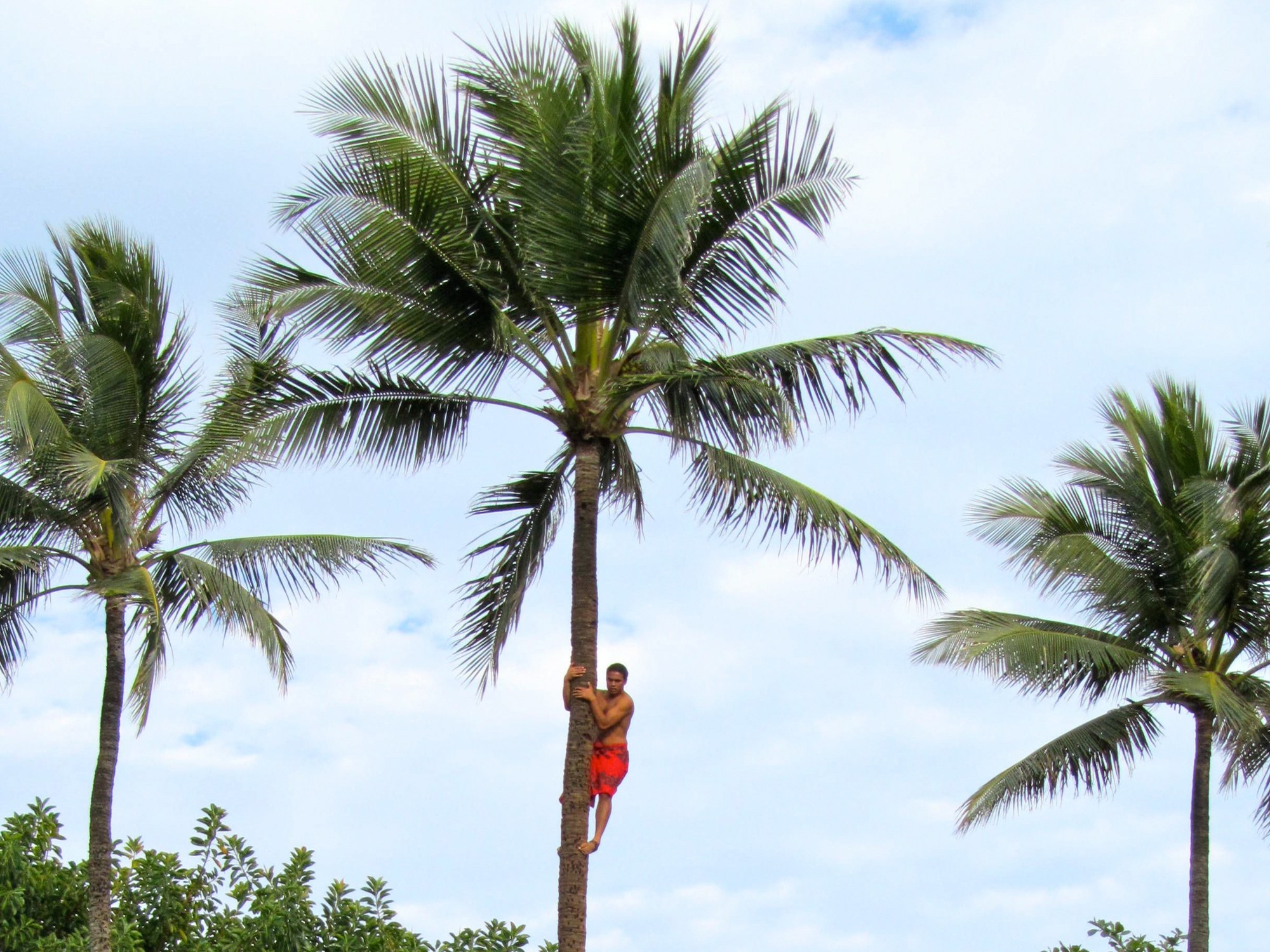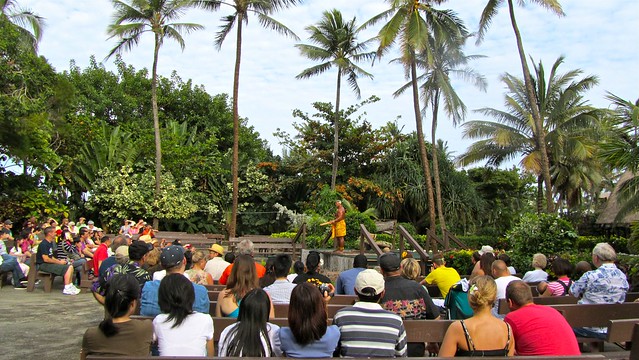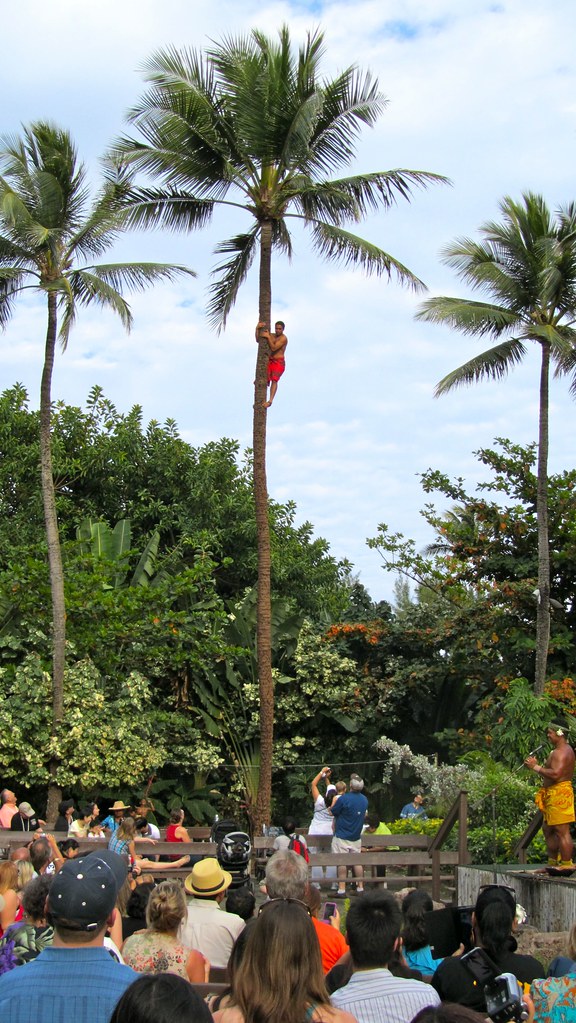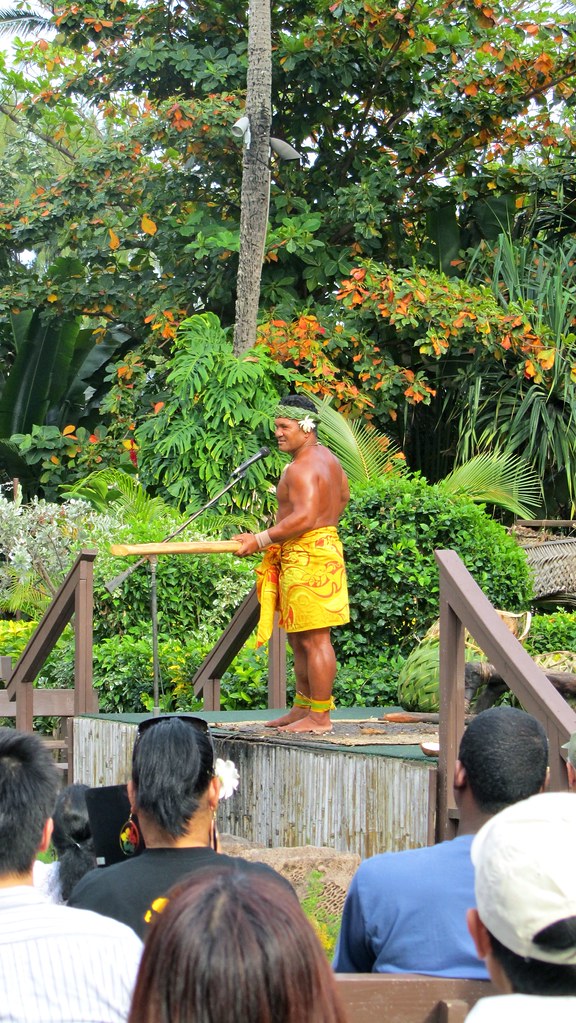Does it Have to be Authentic to be Educational? – Hawaii’s Polynesian Cultural Center

Hawaii. Tahiti. New Zealand. Samoa. …
These Pacific island nations are thousands of miles apart on a map. But there's a way to visit all of them and more in a single day.
And no, it doesn't involve time travel. Or teleporting. Or any magic.
You simply need to visit the Polynesian Cultural Center on the Hawaiian island of Oahu.

The Polynesian Cultural Center, close to Oahu's North Shore, bills itself as being “Hawaii's top paid-admission visitor attraction.”
That right there could be a red flag for any potential visitor who tries his/her very best to stray away from the typical “tourist trail.”
And, in fact, the PCC is extremely touristy. You'll see large tour groups milling about wearing matching hot pink stickers or “Hello my name is…” tags hanging 'round their necks. You'll see endless souvenir shops selling sarongs and shell necklaces. You'll pay nearly $3 if you want to buy a bottle of water. There's even a fake volcano.
But, you know what? Despite all this, the Polynesian Cultural Center is actually kind of great.
The Polynesian Cultural Center
The nonprofit center was opened in 1963 so that students at nearby Brigham Young University Hawaii could work their way through college by sharing their island heritage with visitors. Each of the “villages” at the PCC employs natives from a particular island nation, whose job it is to present their culture, history and traditions to all sorts of foreign visitors in a neat little package.
There are 8 villages at the PCC — representing Hawaii, Aotearoa (New Zealand), Samoa, Tahiti, Tonga, Fiji, the Marquesas, and even Rapa Nui (Easter Island). With the exception of Rapa Nui, each village features interactive activities and shows for visitors to watch and take part in.
These shows are an interesting mixture of kitsch and actual information. Somehow, the Polynesian Cultural Center has found a way to make learning fun. In fact, you might not even realize you're learning.
Learning at the PCC
Over in the Tahiti village, dancers take the stage in grass skirts to shake their hips and wiggle their knees. They invite visitors up onstage with them to make fools of themselves. It's hilarious and a great opportunity to collect some video footage ripe for future blackmail, but it's also a taste of traditional Tahitian culture.
The same is true over in the Samoa village. A large, buff man in a brightly-colored sarong makes coconut jokes and flexes his pecks at an audience made up from people from all over the world. And, while he's hilarious, he's simultaneously showing visitors how Samoans traditionally did things, like make fire, and collect, husk, and extract milk from coconuts. You learn things — like the difference between coconut juice and coconut milk — without even really knowing it.
Sure, these same audiences are then going to go watch a “canoe pageant” float down an artificial river, and later will stuff their faces at an all-you-can-eat buffet while watching hula dancers.
But, whether they realize it at the time or not, they're being immersed in different cultures with every silly thing they do or see.
The performers in each of the villages are well aware that their (paying) audiences are expecting to be entertained. Visitors are not coming to the PCC to listen to a lecture on the Treaty of Waitangi or take notes on the impact of Captain Cook on the Pacific Islands. No, they want to watch fire dancing and see hakas and hear luau music.
But that doesn't mean that the performers have to completely fabricate history or tradition, or bastardize the real thing so much that it becomes a fabrication.
Instead, they must adapt it, perhaps dumb it down a little, and figure out the best way to present it to an extremely diverse audience.
They are all very, very passionate about presenting their cultures in as authentic a way as possible, while still delivering that entertainment factor.
One of the young women working in the Aotearoa Maori village told me that she was actually raised in Australia, and knew very little about her New Zealand heritage until she moved to Hawaii and started working in the Aotearoa village at the Polynesian Cultural Center. Now, she shares the knowledge she's gained about traditional songs, dances and games with visitors from all over the world.
She takes part in the traditional Maori welcoming ceremony that guests can experience 3 times a day. Inside a beautifully carved meeting house, she performs Maori songs and dances with others in full costume. And, after the show, she teaches people how to swing poi, play Maori stick games, and even how to train like an ancient warrior.
Can it still be authentic?
In a world that's all about commercialization, you could easily argue that the experience at the Polynesian Cultural Center is not at all authentic. And you'd be partially right.
But just because it's not 100 percent authentic doesn't mean it's not at all valuable.
The PCC allows visitors to learn about places that they may never actually visit themselves. For example, in the Tahiti village, only 3 people in an audience of about 100 had ever been to Tahiti. So the other 97 were getting a taste of an island they might not ever see in person. As far as I'm concerned, something is better than nothing.
I could go into a rant about whether seeing a similar performance in Tahiti would even be “authentic.” But the authenticity debate could go on forever and never come to agreement, so I won't even go there.
The bottom line is, as kitschy and touristy as places like the Polynesian Cultural Center can be, they can also be a window into the cultures and traditions of other nations — some that, perhaps, many people know nothing about.
And that, I think, is worth it.
IF YOU GO
General admission into the Polynesian Cultural Center starts at about $60, which gives you access to all the villages for a day. If you want to attend the luau buffet, or the “Ha Breath of Life” performance in the evening (which I'm told is amazing), it costs extra.
You can get to the Polynesian Cultural Center by taking the Honolulu city bus (Route 55 will drop you off right outside the PCC). Check out the website for more information on when each village puts on performances and has interactive activities going on.
You can also buy discount tickets to the PCC luau here.
What's your take on places like the PCC? Tourist trap, or potential educational experience? Would you go?

Amanda Williams is the award-winning blogger behind A Dangerous Business Travel Blog. She has traveled to more than 60 countries on 6 continents from her home base in Ohio, specializing in experiential and thoughtful travel through the US, Europe, and rest of the world. Amanda only shares tips based on her personal experiences and places she's actually traveled!













“But just because it’s not 100 percent authentic doesn’t mean it’s not at all valuable.” – This is the key right here. I totally agree with this. I own a resort in Fiji, in Taveuni. I have to tell you that in the past few years, I noticed that tourists that visited knew more and more about Fijian culture, traditions, and had their own itineraries already set up. Why? Because they were informed. They visited such cultural centers (there are actually many around the world that tackle Fijian culture) and went online. However, the authentic experience is at the destination. What our travelers expected and what they actually got was not exactly the same. For instance, Kava, it is so popular in the US right now. People come here and literally expect to get a strong buzz (especially teenagers). That is not the case. In fact, Kava for most people has only a very mild effect, especially those coming from countries where strong spirits are a part of their tradition, like Russia or Eastern Europe. It is good to have these cultural centers but I do think a little focus should be put on highlighting the differences. It does not seem to be the case and this idea of selling an authentic experience is not that accurate.
We love learning about cultures around the world. As a mom, and blogger of how to make travel educational for children, this type of activity is right up my alley! Kids are so visual and learning this way will help them really internalize their memories. How many people sign up for a tour and have that thought, “It is Tuesday so this must be Germany?” and when they get back they can’t even identify their photos.
There are some wonderful cultural opportunities that can’t be seen on one trip…perhaps you aren’t there during the right time of year for that event (like Mardi Gras) or you aren’t invited to a wedding to see a traditional luau in practice. Learning about them at a cultural center like this is the next best thing. ALL learning is good, right?
Learning is definitely good! And even touristy learning is still learning.
I think it for me comes down to how authentic it actually is as opposed to how generic has it become to fit into a set space and time? Maybe for islands the culture is actually closer to homogeneous, but I compare this a little to Epcot in Florida. I love the place, my favorite park in the Disney complex, but the lands there feel somehow more kitschy. If the PCC somehow feels more authentic, I would love to go. If however they end up feeling like a scripted show, then I’d rather spend money somewhere else. Note my point here is feel. Can they make the learning and entertainment feel authentic.
You make a good point! And, as far as kitsch goes, there’s some measure of it at the PCC. But each village presents itself differently, so you don’t necessarily feel like you’re seeing the same thing over and over. In the Aotearoa village, for example, things are done as traditionally as possible, while still keeping in mind the wider tourist audience. It’s interesting. In some cases, I think it DOES feel somewhat authentic.
I think that as long as you are learning from each and every experience you have throughout your travel, then it is a good experience. What is authentic anymore, anyway? We all try and get off the beaten path and try and have a unique experience, but really we are just kidding ourselves. Authentic experiences are our own perception of what we have experienced. An authentic experience will be something different for each individual. Great post. Very insightful and though provoking.
I could not have said it better myself. Travel and tourism run a fine line when it comes to authenticity and exploitation of a culture, I think… but that’s for another post. You’re right though – everyone seems to be reaching for that off-the-beaten-path experience these days, can we even call that authentic anymore?
I was one of those people ranting about this place but as I was reading your post, the thing that I can connect to this most personally with me is the Farm Show they have at the Agrodome in Rotorua. So kitsch but very entertaining and informative as well. Cheese-y but I loved it!! Maybe because it was animals and not actual peoples and cultures.
Things like this just aren’t my thing at all. I never watched a Haka show or aboriginal dancing or things like this put on for the pure entertainment of tourists. And I am not even going to hit on the religious aspect of the place (since it is owned by BYU…)
But I am glad you are having a good time in Hawaiiiii!!!
The Agrodome shows are a good comparison — totally put on for tourists, but still educational, too.
Places like the PCC definitely aren’t for everyone, and it sounds like it probably wouldn’t be for you. But that’s totally okay!
Definitely looks/seems like an authentic window to me! Great post!!!
Glad you think so! And thanks for reading.
It might not be 100% authentic but as long as people are learning something while enjoying themselves, it’s all good, right? Definitely a step up from spending the whole day sunning on a beach (nothing wrong with that too – just make sure to put on lots of sun screen).
I couldn’t agree more. Sure, it’s nice to go to a tropical island and while away the days on the beach. But I think it’s important to also learn a little bit about that beach that you’ve planted yourself on and the surrounding area. So places like the PCC are perfect for that.
And yes, as long as people are learning SOMETHING (even if it’s just how to wiggle their hips and knees like a Tahitian dancer), that’s better than nothing in my book!
I agree with you here. I’m feeling the same way in New Zealand right now. Here and there we’ve happened upon a replica of an original Maori fishing village or museum exhibits, but I don’t think we’ll find too many other places to discover the native culture until we reach Rotorua at the end of our trip. The reality is that most places in Hawaii are just like the rest of the US. You may go to a luau or speak to some true Hawaiian natives to learn a bit more about the culture, but to really get a big educational dose, you probably do need to visit a cultural centre like this one.
I’m glad I’m not the only one feeling this way. I know a lot of people kind of turn up their noses at these sorts of places. But I think they’re really valuable in keeping culture alive and sharing it with others.
Rotorua is a great place to experience some Maori culture. Lots to choose from!
[…] This post was mentioned on Twitter by Tiptoe Traveller, Amanda Williams. Amanda Williams said: Authenticity and tourism – your thoughts? http://wp.me/p10Ebd-1wx #travel […]
Fascinating,
I remember going to a different island when I was a kid, they had this village tour that the natives used to live in and they showed us practical stuff they would do some with authentic tools and some with not authentic tools because they were not longer available/made/whatever. I don’t know a whole lot about authenticity vs non authenticity, but I have to wonder the more authentic it would be the more boring it could be for visitors?
I knew about the PCC, I didn’t have time to go when I went, are you able to visit the PCC in a whole day for $50? I so wish I was there today, I was supposed to be there today for a week :(. I think the three biggest things about Hawaii/Oahu that I am interested in mostly are: Hawaii in general (island tours, try not to do this on a rainy day), visiting the corals via diving or snorkeling and Pearl Harbor.
Beaches and dances are not my thing, I have seen the dances before, have fun and keep up with the good writes 🙂 . Have you thought about writing about the place where you’re staying?
The PCC was pretty cool. I think you could easily see it all in one day for $50 (though, like I said, if you want to have dinner there and see the show, it’s quite a bit more).
As far as writing about where I’m staying, I’m actually staying with a friend in her apartment. Sooo I don’t think reviewing it would be useful for very many people! Haha.